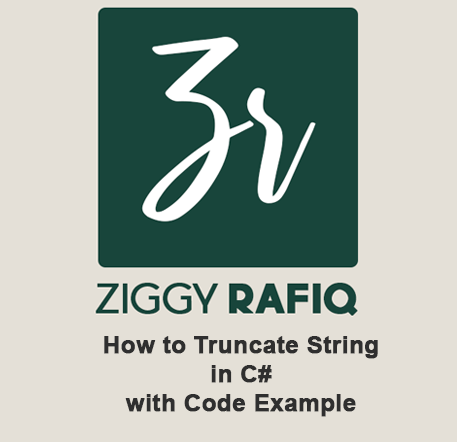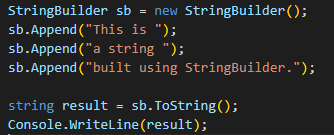Overview
In today’s post, I am writing about one of the fundamental aspects
of C# and as programmers, we should use this approach I have realised throughout
my life as a software engineer that not everyone knows the most basic approaches
or how to use them efficiently. Truncating a string in C# means reducing the
length of a string to a specified number of characters, typically by removing
characters from the end of the string. This is often done when a string is too
long to be displayed or used in a specific context and needs to be shortened to
fit. Ley says if we have a string that is 100 characters long, but we only want
to display the first 50 characters, we will truncate the string to a length of
50. There are several ways to truncate a string in C#, including using the Substring
method, StringBuilder, and LINQ.
A simple example of this is below, we're creating a longString
variable with a long string value. We're also defining a maxLength variable
with a value of 20, which is the maximum length we want the truncated string to
be.
We then use the Substring method to get a portion of the
original string up to the maximum length. The first parameter of the Substring
method is the starting index of the substring, which is 0 in this case since we
want to start from the beginning of the string. The second parameter is the
length of the substring we want to get, which is maxLength in this case.
The resulting truncatedString variable will contain the first 20 characters of the original string. We then output this truncated string using Console.WriteLine. we can adjust the value of maxLength to truncate the string to a different length.
StringBuilder
StringBuilder is a class in the System.Text namespace provides
a more efficient way to manipulate strings than using the String class. The
StringBuilder class allows you to append, insert, replace, or remove characters
in a mutable string.
Using a StringBuilder can be more efficient than using the
String class because String objects are immutable, which means that every time
you modify a string, a new String object is created in memory. On the other
hand, StringBuilder allows you to modify a single string in place, without
creating new objects.
Substring Method
Substring is a method of the String class that allows you to
extract a substring from a string.
The Substring method has two overloads. The first overload
returns a substring that starts at the specified index and continues to the end
of the string. The second overload returns a substring that starts at the
specified index and has a specified length
In the code example below we're creating a string object and
using the Substring method to extract a substring that starts at index 7 and
has a length of 5. The resulting substring is "world", which we then
output to the console.
In another example of code below we're creating a string
object and setting a maximum length for the truncated string. We're then using
the Substring method to extract the first maxLength characters of the string
starting from index 0. The resulting truncated string will have a length of 10,
containing the characters "This is a ".
LINQ
LINQ stands for Language Integrated Query and is a feature
of C# that allows you to query collections of objects using a syntax that is like
SQL. LINQ provides a consistent way to work with data, regardless of its
source, such as collections, databases, or XML documents.
LINQ is implemented using extension methods on collections,
and it allows you to filter, sort, group, and transform data in a concise and
readable way.
We can use LINQ to truncate a string by using the Take
extension method. The Take method allows you to take a specified number of
characters from the beginning of a string and returns a new string.
In the below code example, we're creating a string object
and setting a maximum length for the truncated string. We're then using LINQ to
take the first maxLength characters of the string using the Take method and create
a new string from the resulting array using the ToArray and string constructor
methods. The resulting truncated string will have a length of 10, containing
the characters "This is a ".
Summary
I have covered the technique of how to truncate a string
refers to reducing the length of a string by removing characters from either
its beginning or end. There are several ways to truncate a string in C#,
including using the Substring method, the StringBuilder class, and LINQ's Take
method. The Substring method allows you to extract a substring of a specified
length from the beginning of a string. The StringBuilder class provides a more
efficient way to modify strings than using the string class directly and can be
used to remove characters from either end of a string. The Take method of LINQ
can be used to extract a specified number of characters from the beginning of a
string. When choosing a method to truncate a string, it is important to
consider the size of the string, as well as the specific use case, as different
methods may have different performance characteristics.
I have shared the source code for this post on my GitHub Repository, which is the following URL address- Click Here to Access Source Code For This Post.







Comments